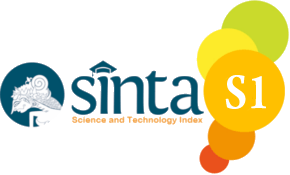KONSTRUKSI TEORI PARADIGMA THOMAS S. KUHN
Abstract
Keywords
Full Text:
PDFReferences
Acikgence, Alparslan. “The Framework for A history of Islamic Philosophy”, Al-Shajarah, Journal of The International Institute of Islamic Thought and Civilization (ISTAC), 1996
jilid1. Nomor 1&2.
Acikgence, Alparslan. Scientific Thought And Its Burdens, An Essay in the History and Philosophy of Science. Fatih University Publications, 2000.
Al-Attas, Syed Muhammad Naquib. “Opening Address The Worldview of Islam: An Outline” dalam Sharifah Shifa Al-attas (Ed.), Islam and Challenge of Modernity. Kuala Lumpur: ISTAC, 1996.
Hasbullah, Moeflich (Ed.). Islamisasi Ilmu Pengetahuan. Jakarta: Pustaka Cidesindo, 2000.
Hawkins, Joyce M. Kamus Dwibahasa Oxford Fajar, Ed. 3, cet. 2. Malaysia: Fajar Bakti Sdn Bhd., 2002.
Heriyanto, Husain. Paradigma Holistik Dialog Filsafat, Sains,dan Kehidupan Menurut Shadra dan Whitehead. Jakarta Selatan: Teraju, 2003.
Hoodbhoy, Pervez. Islam and Science. Kuala Lumpur: Abdul Majeed & Co., 1992. Kuhn, Thomas. The Structure of Scientific Revolutions, Ed. 2. Chicago: University of Chicago Press, 1970.
Longman. Dictionary Of American English, cet. 3. China: Morton Word Processing Ltd., 2002.
M. Q, Patton. Qualitative Evaluation and Research Methods , Edisi: Second. Newbury Park, CA: Sage, 1990.
Needham, J et.al. A Shorter Science and Civilization in China, vol. I. Cambridge: Cambridge University Press, 1978.
Ritzer, George. Sosiologi Pengetahuan Berparadigma Ganda, terj. Alimandan, cet. 5. Jakarta: Rajawali Press, 2004.
Sardar, Ziauddin. Thomas Kuhn dan Perang Ilmu. Jogyakarta: Jendela, 2002.
Smart, Ninian. Worldview, Crosscultural Explorations of Human Belief. New York: Charles Sribner’s sons. The Columbia Encyclopedia, Ed. 3. Washington D.C.: National Science Teachers Association, 1963.
The Grolier International Inc., Encyclopedia Americana. Canada: Americana Corporation, 1980.
Wall, Thomas F. Thinking Critically About Philosophical Problem, A Modern Introduction. Australia: Thomson Learning, 2001.
DOI: http://dx.doi.org/10.22373/jiif.v11i2.55
Refbacks
- There are currently no refbacks.
Welcome to Jurnal Ilmiah Islam Futura (JIIF) open journal system. Thank you very much for visiting. We are looking forward to getting your research articles
Jurnal Ilmiah Islam Futura
All works are licensed under CC-BY
©Published by Center for Research and Community Service (LP2M) in cooperation with the Postgraduate Program of UIN Ar-Raniry Banda Aceh, Aceh, Indonesia.





